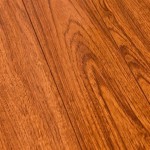Bamboo Strand Flooring: Exploring the Pros and Cons
Bamboo strand flooring has emerged as a sustainable and versatile flooring option, offering a unique blend of aesthetics and durability. Crafted from individual bamboo fibers compressed together, this flooring comes with its own set of advantages and disadvantages that are worth considering before making a choice. Let's dive into the pros and cons of bamboo strand flooring to help you make an informed decision.
Pros of Bamboo Strand Flooring:
1. Sustainability:
One of the primary benefits of bamboo strand flooring is its environmental friendliness. Bamboo is a renewable resource that grows at a rapid rate, making it a sustainable choice compared to traditional hardwood flooring.
2. Durability:
Bamboo strand flooring boasts exceptional durability, often comparable to hardwood flooring. Its high density and cross-grain construction provide resistance to wear, scratches, and dents, making it suitable for high-traffic areas.
3. Water Resistance:
Unlike solid wood flooring, bamboo strand flooring exhibits enhanced water resistance. The compressed fibers make it less susceptible to moisture absorption, reducing the risk of warping or buckling.
4. Stability:
Bamboo strand flooring is dimensionally stable, meaning it is less likely to expand or contract with changes in temperature or humidity. This stability ensures a consistent appearance and prevents gaps or buckling over time.
5. Aesthetics:
Bamboo strand flooring offers a visually appealing texture and color variation. The natural grain patterns and golden hues add warmth and character to any space, creating a modern or traditional aesthetic depending on the design.
Cons of Bamboo Strand Flooring:
1. Cost:
Compared to traditional hardwood flooring, bamboo strand flooring can be more expensive, especially for higher-quality and wider planks. The manufacturing process and its eco-friendly credentials contribute to the higher price point.
2. Potential Scratches:
While durable, bamboo strand flooring can still be susceptible to scratches from sharp objects or heavy furniture. Proper care and maintenance, such as using felt pads under furniture, are crucial to prevent damage.
3. Color Changes:
Over time, bamboo strand flooring can undergo slight color changes due to exposure to sunlight. The natural yellow hues may fade or turn slightly darker, depending on the intensity and duration of sun exposure.
4. Hardness:
Although bamboo strand flooring is harder than many hardwoods, it is still softer than species like hickory or oak. This means it may be more prone to dents or scratches from heavy impacts compared to certain types of hardwood flooring.
5. Limited Refinishing Options:
Bamboo strand flooring is typically finished during the manufacturing process, limiting the options for refinishing or sanding. Unlike solid hardwood flooring, which can be refinished multiple times, bamboo strand flooring has a limited lifespan before needing replacement.
Conclusion:
Bamboo strand flooring presents both advantages and disadvantages that should be weighed carefully before making a decision. Its sustainability, durability, and water resistance make it a compelling choice for eco-conscious homeowners seeking a durable and stylish flooring option. However, consider the potential costs, susceptibility to scratches, and limited refinishing options to ensure it aligns with your needs and expectations.

Bamboo Flooring Pros And Cons Forbes Home

Bamboo Flooring Pros And Cons Diy Family Handyman

Pros And Cons Of Bamboo Flooring

The Pros And Cons Of Bamboo Flooring Astrobrite Local Family Run

Bamboo Flooring Pros Cons Advantages Disadvantages

Advantages And Disadvantages Of Bamboo Flooring The Company

Pros Cons Of Bamboo Flooring Claude Browns

Bamboo Flooring Pros And Cons Ashmore Carpets

Bamboo Flooring Pros Cons Greencompostables Com

Bamboo Flooring Pros Cons S
Related Posts








